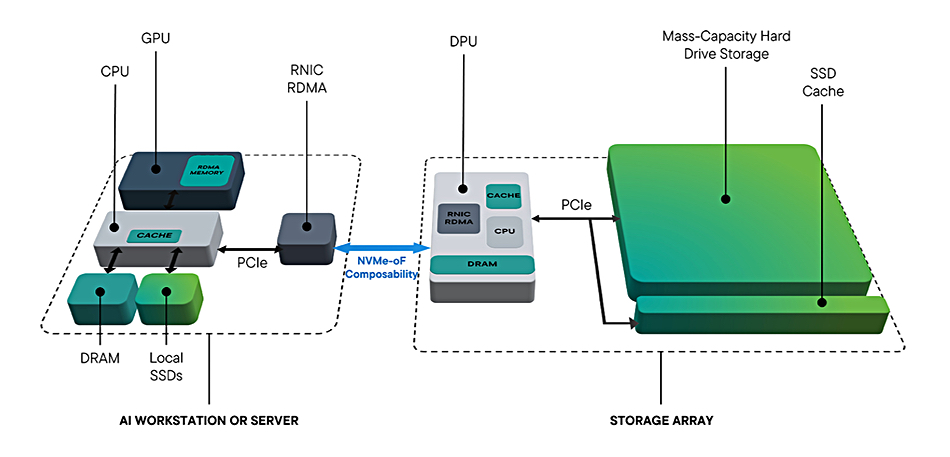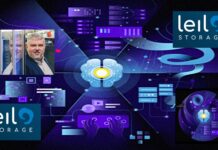A Seagate blog says that fast-access hybrid flash+disk drive arrays are a good fit to AI workload needs because retaining large datasets solely on SSDs is financially unsustainable for most enterprises.
It goes on to say that, by adopting a parallel NVMe interface instead of the existing serial SAS/SATA hard disk drive (HDD) interface, we can “remove the need for HBAs, protocol bridges, and additional SAS infrastructure, making AI storage more streamlined.” By using “a single NVMe driver and OS stack, these drives ensure that hard drives and SSDs work together efficiently, removing the need for separate software layers.”
Access to data stored on NVMe SSDs benefits from GPUDirect protocols with direct GPU memory-to-drive access and no intervening storage array controller CPU involvement with memory buffering of the data to be transferred. Also existing NVMe-over-Fabrics infrastructure can be used “to integrate into distributed AI storage architectures, ensuring seamless scaling within high-performance data center networks.”
This is of no benefit at the individual HDD level where access latency is far more dependent on HDD seek time, with the head moving to the right track and then waiting for the appropriate blocks in the track to spin around underneath the head, than drive controller response time. An SSD has far lower access latency than a disk drive because the controller has fast electrical connections to the data storing cells and is not subject to seek time waits.
Seagate is suggesting that an entire drive array, a hybrid one with both SSDs and HDDS, gets NVMe connectivity to a GPU server. Then the speed of the link, compared to a SATA/SAS 12Gbits connection would enable far higher aggregate connectivity, even taking seek time into account. The HDDs and SSDs would share the NVMe connection to the GPU server, simplifying that side of things.

An RNIC, a BlueField-3 smartNIC/DPU for example, in the array would send data, using RDMA, to its twin in the GPU server, which would be linked to that server’s memory. Seagate built a demo system for Nvidia’s GTC 2025 conference with NVMe HDDs and SSDs in a hybrid array with a BlueField-3 front-end and Nvidia’s AIStore software, which supports Nvidia’s GPUDirect for object data protocol.

It says this was a proof-of-concept idea showing that:
- Direct GPU-to-storage communication via NVMe hard drives and DPUs helped reduce [overall] storage-related latency in AI data workflows,
- Legacy SAS/SATA overhead was eliminated, simplifying system architecture and improving storage efficiency,
- NVMe-oF integration enabled seamless scaling, proving the composability of multi-rack AI storage clusters,
- Model training performance was improved by AIStore’s dynamic caching and tiering.
Seagate says the POC demonstrated the composability of multi-rack storage clusters.
If we agree that “retaining large datasets solely on SSDs is financially unsustainable for most enterprises” then this demo of an NVME-connected hybrid flash+disk array could illustrate that AI workloads don’t need all-flash array architectures.
Seagate says that NVMe-connected HDDs will have applicability in manufacturing, autonomous vehicles, healthcare imaging, financial analytics and hyperscale cloud AI workloads. Compared to SSDs, NVMe hard drives would offer, it says:
- 10× more efficient embodied carbon per terabyte, reducing environmental impact.
- 4× more efficient operating power consumption per terabyte, lowering AI datacenter energy costs.
- Significantly lower cost per terabyte, reducing AI storage TCO at scale.
Seagate has an NVMe HDD roadmap which includes using its 36TB and above HAMR drives, and creating reference architectures.
The company has history here. Back in 2021, it produced a 2 RU JBOD (Just a Bunch of Disks) enclosure housing 12 x 3.5-inch disk drives and accessed through an onboard PCIe 3 switch and NVMe at an Open Compute Summit. That initiative did not spur either Toshiba or Western Digital into doing the same.
Four years later, neither Toshiba nor Western Digital still have any public involvement in adding NVMe interfaces to their disk drives. It’s probable that customers for NVMe-connected hybrid arrays would appreciate freedom from HDD lock-in and single vendor pricing by having NVMe HDD support available from them as well as Seagate.








